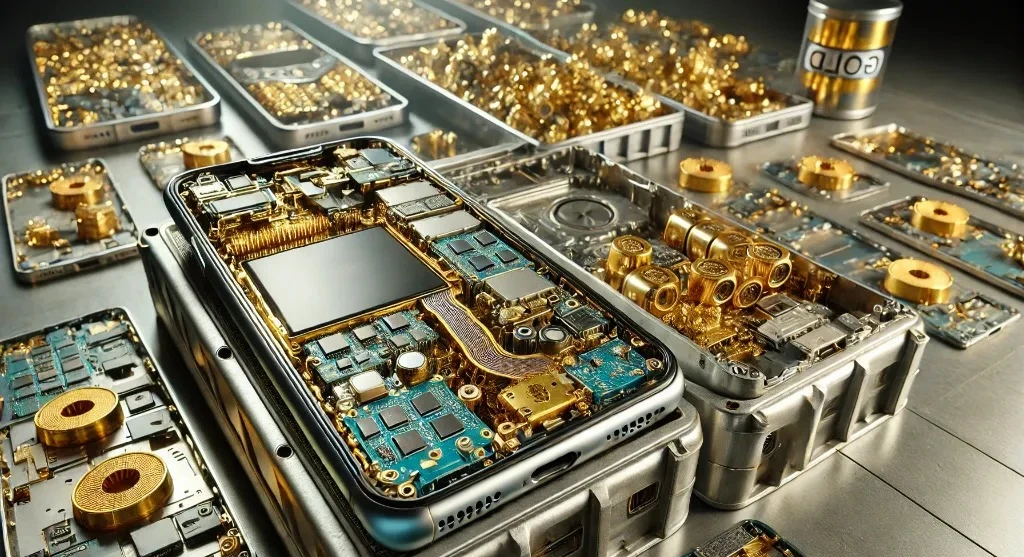There’s Gold in That Junk Drawer
Ever thought that crusty old smartphone gathering dust in your drawer could be a mini gold mine? Seriously—your discarded tech is loaded with precious metals like gold, silver, and platinum. But here’s the kicker: electronic waste is piling up faster than a bad TikTok trend, with a jaw-dropping 82 million metric tons expected by 2030. That’s a mountain of tossed laptops, phones, and TVs, and our old-school recycling tricks just aren’t cutting it. They’re slow, messy, and sometimes toxic. Enter the superheroes of e-waste: AI, automation, and green tech, flipping the script on how we handle our tech trash. This isn’t just nerdy science—it’s a game-changer for the planet and your future.
We’re talking robots tearing apart circuit boards, bacteria munching on metals, and even tree leaves replacing plastic. Sound wild? It is. Let’s dive into how this tech revolution is tackling e-waste and why you should care.
The Tech Takeover
AI Sorting Like a Boss
Forget sweaty workers sorting through heaps of broken gadgets. AI’s stepping in with fancy sensors and brainy algorithms that can spot plastics, metals, and circuit boards in a snap. These machines are like the world’s pickiest librarians, sorting e-waste with laser precision. That means more gold and copper saved, less toxic stuff leaking into the ground, and fewer workers breathing nasty fumes. It’s faster, cleaner, and way more efficient.
Robots That Rip Apart Phones
Meet the robot squad from the iDEAR project—short for “Intelligent Disassembly of Electronics.” These bots use AI to gently take apart old devices without smashing them to bits. It’s like a surgical strike on your ancient iPhone, saving parts for reuse and recycling. The goal? A closed-loop system where nothing goes to waste. Pretty slick, right?
Bacteria Eating Your Circuit Board
Here’s where it gets sci-fi: bioleaching. Scientists are using tiny microbes to chomp on e-waste and spit out metals like copper and gold. It’s like giving bacteria a buffet of old circuit boards, and they’re loving it. This green method skips the toxic chemicals and fiery furnaces of old-school recycling, making it kinder to the planet.
Leafy Circuit Boards? Yup.
Brace yourself: researchers are swapping plastic circuit boards for ones made from tree leaves. No, it’s not a hippie fever dream—these biodegradable boards could slash the 60% of e-waste that’s circuit boards. Your next laptop might be part forest, and that’s a win for Mother Earth.
Why This Matters

For Your Wallet
That gold in your old phone? It’s worth serious cash, but only if we recycle it right. Better e-waste tech means more metals recovered, which could keep gadget prices down. Plus, green recycling creates jobs—someone’s gotta run those AI machines or feed those metal-munching bacteria.
For the Planet
E-waste is a ticking time bomb. Tossed gadgets leak toxins into soil and water, poisoning ecosystems. By 2030, we’ll be drowning in 82 million tons of the stuff if we don’t act. AI, robots, and green tech are like a cleanup crew, stopping the pollution and saving resources. It’s not just about saving the polar bears—it’s about keeping your drinking water clean.
What’s Next?
Tech Keeps Evolving
The e-waste fight’s just getting started. Expect smarter AI, tougher robots, and even wilder green ideas—like blockchain to track gadgets from cradle to grave, making sure they’re recycled right. Companies are testing these now, and they’re not slowing down.
Your Part
You’re not off the hook. Keep your gadgets longer, repair instead of replace, and recycle them properly—check local drop-offs, not the trash bin. Push for tougher e-waste laws, too. It’s like joining a team effort to keep the planet from turning into a tech graveyard.
The Bottom Line
Your old phone’s a treasure chest, but e-waste is a global headache. AI’s sorting like a pro, robots are dismantling with finesse, and bacteria are eating metals for breakfast. Throw in leaf-based circuit boards, and we’ve got a revolution that’s saving resources and the planet. This matters because it’s your world, your gadgets, and your future. So, next time you upgrade your phone, don’t just chuck the old one—help make e-waste a problem we actually solve.


